~~~~~~~~~~~~~~~~~~~~~~~~~~~~
SCUBA News (ISSN 1476-8011)
Issue 162 - November 2013
http://www.scubatravel.co.uk
~~~~~~~~~~~~~~~~~~~~~~~~~~~ ~
Welcome to SCUBA News. Last month we mentioned how we had more dive centres now listed in the Philippines. Since then the Philippines has suffered terribly from Typhoon Haiyan. Our thoughts go out to all the divers, dive shops and ordinary people affected there.
The most severely damaged area is the Eastern Visayas with Samar and Leyte being particularly badly hit. Popular tourist areas like Boracay and the southern parts of Cebu are mostly unaffected, but check before travelling. The website of the British FCO gives the latest advice for the area.
I hope you enjoy SCUBA News, but should you wish to cancel your subscription you can do so at http://www.scubatravel.co.uk/news.html.
You can also download a pdf version of this newsletter. SCUBA News is published by SCUBA Travel Ltd.
Contents:
- What's new at SCUBA Travel?
- Interview with Richard Field, Author of Reef Fishes of Oman
- Creature of the Month: Conger Eel
- Diving News from Around the World

For Diving Travel Insurance with diving to 50 m, go to World Nomads, the adventure travel specialists




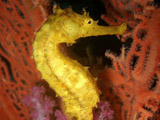
Where are the Best Dive Sites in Thailand?
The best diving in Thailand is in the Andaman Sea, to the west of the kingdom. Two dive sites you shouldn't miss are Hin Daeng (Red Rock) and Hin Mouang (Purple Rock). These world-class dive sites deserve to be in every divers' top 10. Read more at
http://www.scubatravel.co.uk/thailand/thaidive.html
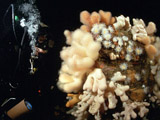
Diving in the UK
The UK has some fabulous diving in her seas, not least on the hundreds of wrecks. There is also beautiful marine life and at times amazing visibility. An estimated 8500 species of plant and animal live in UK waters. We've now more British dive centres and clubs listed at
http://www.scubatravel.co.uk/europe/uk-diving.html
Don't forget to keep sending us your reviews. E-mail news@scubatravel.co.uk or fill in the form at the website.

We interviewed Richard Field about his new e-book, Reef Fishes of Oman, a photographic guide to the fish you are likely to see diving Oman's waters. More interviews with authors and diving book reviews are on the website.
You were a pioneer of underwater photography, could you tell us a little about those days?
I have never regarded myself as a pioneer. My interest in Red Sea fishes began in Port Sudan when an Australian marine biologist produced a book 'Red Sea Fisheries of Sudan' for the Sudan government. He was working on a pearl cultivation project and I helped him with some sampling work. All free diving of course since SCUBA was not available. All the fishes in his book were hand drawn by the Port pilot's daughter. I resolved there and then to produce, sometime, a Red Sea fish book with photographs. To start I had to find a camera (not easy in Port Sudan in 1964). Having done so, I made a housing out of scrap telecommunications equipment, and started taking underwater photographs (black and white, of course !), though with limited success.
Although you've been free diving since the 60's you didn't learn to scuba dive until 1993 - do you regret taking so long to do so?
Up to the early 90's I was very happy with free diving and could not understand how people could load themselves with heavy gear to go into the water. My son changed all that when, at the age of 12, he insisted on taking his PADI OW course. So I felt obliged to take the course with him.
Why did you decide to publish digitally rather than as a paperback?
An ebook is readily updateable and amendable. A photo is easy to replace with a newer and better image and name changes (which are frequent) can be quickly changed. I like to be in control of content !
Your web site is called "Reef Fishes of Arabia, The Essential Guide" is that what you were going to call the book originally, and if so why the change?
Yes, originally that was the idea, but unfortunately I do not have enough experience to include the Gulf of Aden. This is an interesting area (not on the tourist map !) where species overlap in distribution from the Red Sea and the Arabian Sea.
One of the fish in the book is named Chromis fieldi - was this named after you?
Yes, Dr JE Randall kindly honoured me by naming the Indian Ocean species Chromis fieldi. This was a Field family affair, my wife Mary and son Francis helped in collecting specimens of Red Sea Chromis dimidiata to demonstrate that it is a different species to that found in the Indian Ocean.
Has there been an occasion when you didn't take your camera underwater and really wished you had?
I always carry a camera. I once regretted taking my camera though. I was attending a Fish Conference in Durban, South Africa and after the conference Mary and I joined a group of marine biologists for a week's diving and specimen collecting in Sodwana, near the Mozambique border. My first dive was very short - my housing flooded immediately since I had forgotten to reseal the housing after the flight from UK. To add to the pain, Mary had decided not to bring her camera on the trip !
Which is your favourite dive site?
A good dive site for me is one that contains a great diversity of marine fauna. The Daymanyat Islands of Oman, perhaps.
Are you planning any other books?
I am currently working on a revamp of our book 'Reef Fishes of the Red Sea', published in 1998. This will also be an ebook.
Reef Fishes of Oman is available for 5.99 Euro from Reef Fishes of Arabia. You must click the "Return to derenyimaria @ yahoo.co.uk" link to be directed to the download page.
Read more interviews with diving authors at http://www.scubatravel.co.uk/interview.html
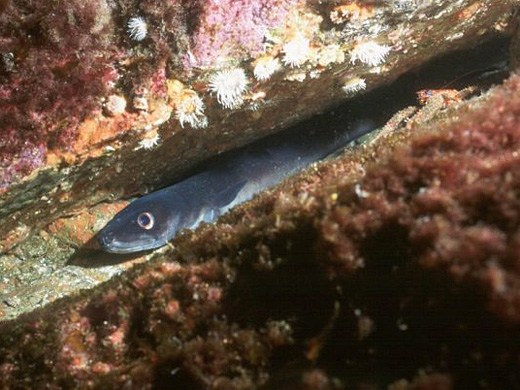
The conger eel has the easiest-to-remember Latin name of them all: Conger conger. This massive fish can grow to almost 3 m (10 ft) long, the females often being bigger than the males.
Distinctive in shape, the conger lacks scales and has one long fin which stretches from behind the head, all along the body and round the tail to underneath its body. This fin is actually a fusion of the dorsal, tail and anal fins.
Conger eels are widespread. You find them in the Eastern Atlantic from Iceland to Senegal, in the Mediterranean and in the Black Sea. They like to hide in holes and crevices. At night they hunt fish and crustaceans like crabs and lobsters. In spite of this divers often see crustaceans sharing a hole with a conger. If you look closely at the photo above you can see squat lobster alongside the eel.
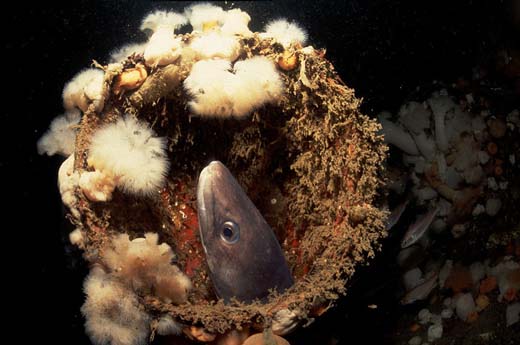
Congers breed only once in their lives, at between 5 and 15 years of age. They migrate to deep water to spawn - some sources say as deep as 4000 m - in one or more areas between Gibraltar and the Azores in the mid-Atlantic. After spawning they die, their larvae drifting back into coastal waters.
Evidence suggests that the eels are being over-fished, but they have not yet been assessed by the IUCN.
Conger eels are very strong and have been known to attack divers. However, they are docile unless provoked.
Further Reading
Great British Marine Animals by Paul Naylor
The Marine Life Information Network
Population structure and connectivity of the European conger eel (Conger conger) across the north-eastern Atlantic and western Mediterranean: integrating molecular and otolith elemental approaches. Mar Biol (2012) 159:1509–1525, Alberto T. Correia et al.
Photos by Tim Nicholson, whose books and photos are available from http://www.photoboxgallery.com/timnicholson
For breaking news see our Twitter page or RSS feed
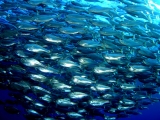
Philippines urges action to resolve climate talks deadlock
UN negotiations in Warsaw must deliver emergency climate pathway as new storm brews in the Pacific, says government.
Sardine disappearance was foreseen but ignored
Western Canada's sardine fleet returned with no fish last month. The loss of the fishery, normally worth CAN32 million, took many by surprise. Yet researchers warned last year that it could happen.
Training centre for fishermen to open in Maldives
A new Fishermen's Community and Training Centre in the Maldives will nurture the country's pole-and-line fishing communities through the provision of fisheries training and education.

Underwater Internet coming Soon?
You don't usually find a wireless network whilst underwater, but that may change as researchers at the University at Buffalo are developing a deep-sea internet. They hope that this technological breakthrough will lead to improvements in tsunami detection, pollution monitoring and other activities.
New Sensor Monitors Ocean Acidification
Scientists and engineers have achieved the first step in developing a cost-effective micro sensor for long-term monitoring of ocean acidification.
Japan's Dolphin, Whale And Porpoise Hunts Threaten Species With Extinction
Catch quotas are based on data collected as much as 20 years ago and some species have been overhunted beyond the point of recovery, the Environmental Investigation Agency said in a new report.
Third time unlucky for Antarctic protection bid
Marine reserve failure raises questions over polar conservation.
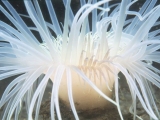
The stealth tax that says to hell with North Sea cod stocks
Through the UK government body Seafish, the public is paying lobbyists to torpedo a campaign to protect the natural world
Tube worm lights up the undersea night with vitamin B
A new study has pinpointed exactly how a tube worm's mucus lights up the seas.
* Copyright SCUBA Travel - http://www.scubatravel.co.uk/
* Reprinting permitted with this footer included.
We are happy for you to copy and distribute this newsletter, and use parts of it on your own web site, providing the above copyright notice is included and a link back to our web site is in place.
Photo credits: Tim Nicholson, Douglas Levere
Previous editions of SCUBA News are archived at http://www.scubatravel.co.uk/news.html
SUBSCRIBING AND UNSUBSCRIBING
Visit this link and add or remove your e-mail address. To change whether your receive the newsletter in text or HTML (with pictures) format visit this link
ADVERTISING
Should you wish to advertise in SCUBA News, please see the special offers at
http://www.scubatravel.co.uk/newsad.html
Other advertising opportunities are at
http://www.scubatravel.co.uk/advertising.html
CONTACTING THE EDITOR
Please send your letters or press releases to:
Jill Studholme
SCUBA News
The Cliff
Upper Mayfield
DE6 2HR
UK
news@scubatravel.co.uk
PUBLISHER
SCUBA Travel Ltd, The Cliff, Upper Mayfield, DE6 2HR, UK
No comments:
Post a Comment